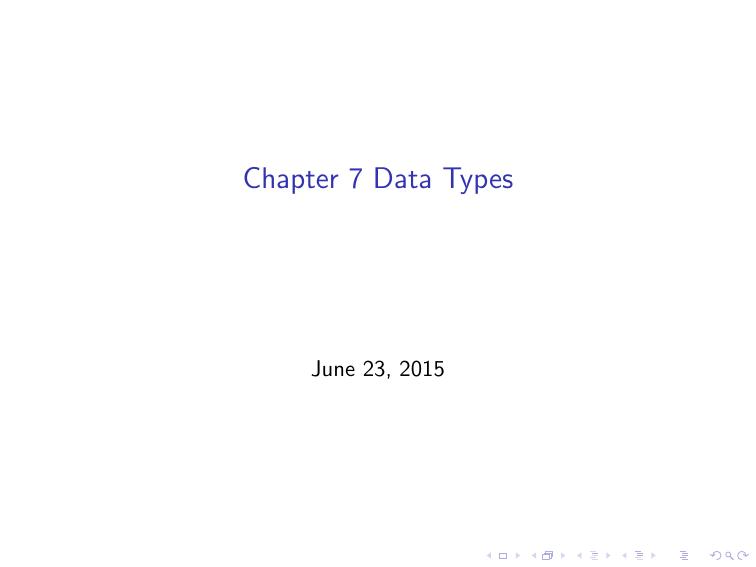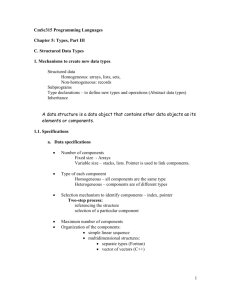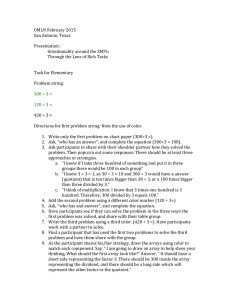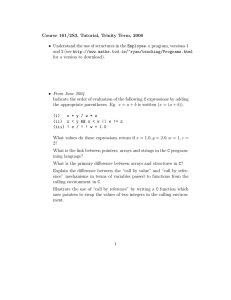Chapter 7 Data Types June 23, 2015
advertisement

Chapter 7 Data Types
June 23, 2015
7.1 Type systems
I
Hardware can interpret bits in memory in various ways: as
instructions, addresses, integers, floating point, fixed point, or
perhaps even as character data.
I
But bits are bits; types are conceptually imposed over the bits,
and not realized in hardware.
7.1 Type systems
I
A type system consists of
I
I
a mechanism to define types and associate these types with
language constructs
and a set of rules for type equivalence
7.1 Type systems and subroutines
I
So what about subroutines? Some languages imbue these with
type; others don’t. If a subroutine is first-class, that’s a strong
reason to give a type; if it is third-class, and the language is
statically scoped with no provision for dynamic references to a
subroutine, then one could dispense with types for subroutines.
7.1.1 Type checking
I
Type checking is an attempt to ensure that a program
enforces its type compability rules. Violations are genearlly
called a type clash.
I
A language can be called strongly typed if it prohibits the
application of any operation to any object that is not intended
to support that application.
I
A language can be called statically typed if it is strongly typed
and type checking can be performed at compile time. (The
term is also sometimes applied to languages that can do most
of their type checking at compile time with only a small
portion done at run time.)
7.1.1 Type checking
I
“Dynamic type checking is a form of late binding” [page 291],
and is a common attribute of languages that do other forms
of late binding.
I
See also Wikipedia’s take on this
7.1.2 Polymorphism (revisited from page 148)
I
Fundamental definition: “Polymorphism allows a single body
of code to work with objects of multiple types.” [page 291]
I
This idea becomes more subtle than one might think, and
often what polymorphism actually entails is part and parcel of
the language definition.
I
For instance, Haskell’s take on its polymorphism.
7.1.3 The meaning of “type”
I
I
I
Some languages offer on a small set of fixed types (Fortran 77
and Basic, for instance)
Some languages can infer types at compile time (ML and
Haskell, original work was done by Milner; take a look at
Mil78 in the book’s references on page 860)
Most languages depend on the programmer to provide type
declarations.
7.1.3 Three ways to think about types
I
Denotational: a type is a set of values. This way of thinking
lets us use the well-honed tools of set theory.
I
Constructive: a type is either built-in, or can be constructed
from other types.
I
Abstraction-based: a type is an interface consisting of a set of
operations with well-defined and consistent semantics (and
that is a pretty abstract definition since it seems to cover
more than just types)
7.1.4 Classification of types
I
Numeric types: unfortunately, a lot of languages are quite
lackadaisical about just how many bytes are in their numeric
types. Some languages have signed and unsigned types; some
have fixed point numbers or BCD; some languages support
complex numbers, rationals, imaginary numbers, and even
p-adic numbers.
I
Scripting languages usually support multiprecision numbers.
7.1.4 Enumeration types
I
Since Pascal, it has been common for languages to allow
enumeration as a set of values that generally given as a
sequence of characters.
type weekday = (sun, mon, tue, wed, thue, fri, sat);
for today := mon to fri do begin ...
var daily_attendance : array [weekday] of integer;
7.1.4
I
Some languages have treated these enumerations as some
version of integer, and allowed integer operations over these,
like C:
enum weekday {sun, mon, tue, wed, thu, fri, sat};
int main()
{
enum
enum
enum
day3
}
weekday day1 = sun;
weekday day2 = mon;
weekday day3;
= day1 + day2;
7.1.4 Subranges
I
Many languages allow constructions like 12..24 or sun..fri.
I
Haskell, because of its lazy evaluation scheme, even allows
just 12..
7.1.4 Composite types
I
I
I
I
I
I
I
Records/structures
Variant records/unions
Arrays
Sets
Pointers
Lists
Files
7.2.1 Type equivalence
I
I
I
I
Structural equivalence: two types are equivalent if they have
the same components in the same order.
Name equivalence: different names mean different types, even
if they are structurally identical.
But what if you create type x = y, thus creating only an alias?
Strict name equivalence means that aliases are different; loose
means that aliases are treated as equivalent.
Ada lets you specify how you want it viewed.
7.2.1 Type conversions and casts
I
I
I
Could be merely conceptual if the underlying representations
are the same
Could be that the underlying values are formed the same way,
but still might need run-time checks to verify that
non-translatable values are detected.
Could be that the underlying representations are different, but
that feasible means exist for creating correspondences
(integers to reals, for instance.)
7.2.2 Type compatibility
I
Some languages allow a lot of “type compatibility”, going to
the extent of doing extensive type coercions (Perl is a champ
at this; C also does quite a number.)
Containers
I
Some languages that allow “containers” also allow a
“universal” reference type (think of C’s void *, for instance).
These usually lead to some difficult questions, though, that
end up having run-time solutions, such as including a type tag.
7.2.3 Type inference
I
Consider the following:
type Atype = 0..20;
type Btype = 10..30;
var a: Atype;
var b: Btype;
I
What if you wanted to add a to b? Does that even make
sense? If so, what “type” would the result be? How about
just making it an integer? Or . . . ?
What about indexing?
I
Some languages infer the type of an index. . . if a language
does so, should that be an implicit subrange type?
7.3 Records/Structures and Variants/Unions
I
Fundamentally, records and structures allow 1) aggregation
into a single data structures components of different types and
2) a method of addressing each component of an aggregate
I
Usually this means 1) simply putting components adjacent to
each other in memory, and 2) maintaing an offset for each
component
Simplifying the syntax
I
Some languages (notably the Pascal family) allow one to
simplify accesses to complicated structures with the idea of a
“with” statement:
with complex.complicated.deep.stuff do
begin
fieldx := ’STUFF GOES HERE’;
fieldy := ’STUFF GOES THERE’;
fieldz := ’STUFF GOES EVERYWHERE’
end;
7.4 Arrays
I
A very common composite data structure. Most languages
have significant syntactical and semantic support for arrays.
Fundmentally, an array takes an index to a value.
I
Your text takes the approach of treating associative arrays as
part of this spectrum of various types of indices; this works
well with the then conflation of arrays with functions.
Array declarations
I
It is popular for programming languages to allow
enumerations and ranges to used in an array specfication.
I
Multi-dimensional array declarations are also common in
programming langauges.
Slices
I
Slices allow one to specify a “rectangular” portion of an array;
Conformant arrays
I
Conformant arrays give the ability to reference the bounds of
an array from its “dope vector” rather than having to pass
these dimensions along explicitly.
Dynamic arrays
I
When the dimensions of an array are allowed to change, it is
said to be “dynamic”; while the meta-information about such
a dynamic array can be kept on a runtime stack, the actual
array needs to be in a heap of some sort.
Memory layout
I
Most languages put all of the elements of an array in a single
contiguous area of memory (though certainly not all; Perl
apparently does not do this with its “l-o-l” (also, look here)).
Strings
I
While many languages treat strings largely as just an array of
characters, some give strings a separate type that allows
operations that are not applicable to other arrays.
I
Generally, most languages give strings a reasonably prominent
place, both in syntax and semantics, since string processing is
so fundamental to real-world problems.
Sets
I
Pascal was the first language to explicitly have a set type; it
overloaded the “+”, “*“, and”-” operators to support support
set union, intersection, and difference.
I
Generally done as a bit vector for smallish sets, and either the
language forbids largish sets, or uses a more sparse approach.
Pointers and recursive types
I
Pointers are fundamental to many implementations of many of
computer science’s favorite idioms: lists, trees, red-black trees,
tries, skip lists, splay trees, scapegoat trees, heaps, sets, . . .
Pointers and models
I
Reclaiming unneeded storage: some languages, like C, leave
this task to the programmer; others automate the process
with garbage collection.
I
Failing to reclaim storage creates memory leaks; conversely,
freeing storage that is still in use creates dangling references.
Freeing already freed storage creates double frees.
Pointers and value models
I
If there’s anything that can be said generally on this subject,
it’s that this has been a “free-for-all” area for programming
languages, spanning various ideas about l-values and r-values,
and what is an explicit reference to a memory location and
what is an implicit one. The best current reference on the
web for this subject is at Rosetta code’s Pointers and
references page.
Note on page 353 relating to “stack smashing”:
I
“It would never have been a problem in the first place,
however, if C had been designed for automatic bounds
checks.”
I
Yes, and I would note that it also would not have been as
serious a problem had return addresses been kept on a
separate stack from activation records; or if there had been
hardware support for array boundaries; or a host other
techniques.
C allows conflation of pointer arithmetic with array access
I
Although it’s past its utility, the original idea of allowing the
programmer to do the pointer arithmetic behind flat array
implementation was quite efficient, though modern compilers
can usually better a programmer’s efforts.
I
Try this program: test-sizeof.c
Garbage collection
I
Reference counting is a popular and relatively simple way to
implement garbage collection, but it needs some language
support (for instance, reference counts in C would be hard to
imagine, since malloc() is not even part of the language but is
rather just a library call.)
Garbage collection
I
Other conundrums:
Garbage collection
I
As the book notes, even Perl is subject to the circular
reference problem.
Garbage collection
I
Mark-and-sweep, classic three steps:
I
I
I
I
Walk “the heap”, identifying every program data item as
“useless”
Walk all linked data structures that are outside “the heap”,
marking all items in “the heap” that are reachable as “useful”
Walk “the heap” again, removing all of the program data
items still marked as “useless”
Implementation issues galore, though, and language
implementations planning to use mark-and-sweep should plan
on this from the beginning
Garbage collection
I
Stop-and-copy, classic unpredictable time problems (also
known as “stop the world” pause problem)
I
Usually fold compaction into this method
7.8 Lists
I
“In Lisp, a program is a list, and can extend itself at run time
by constructing a list and executing it. . . ” (page 365).
7.8 Lists
I
While lists are much of a muchness is most languages, in
many languages (and particularly the functional languages)
now also support list comprehensions.
7.10 Equality and assignment
I
As the text points out, consider equality of s == t expressed
as
I
I
I
I
I
s
s
s
s
and
and
and
and
t
t
t
t
are aliases
contain exactly the same characters
appear exactly the same if “printed”
occupy storage is the same bitwise
While the last is clearly problematic (what if s and t contain
non-semantically significant bits that are not the same?) the
others can be useful measures
Equality and assignment
I
And what about assignment? If s := t and t is a large
recursive structure, the language might just do a shallow copy
of t as a pointer, or maybe it does a deep copy, walking the
entire structure of t and creating a fresh copy in s.
I
Or maybe the language supports both shallow and deep
mechanisms.
7.11 Wrapping up
I
A type system consists of any built-in types, mechanisms to
create new types, and rules for type equivalence, type
compatibility, and type inference
I
A strongly typed language never allows an operation to be
applied to an object that does not support it. (However, the
notions of strong and weak typing are not universally agreed
upon.)
I
A statically typed language enforces strong typing at
compilation time.
7.11 Wrapping up
I
I
I
Explicit conversion: the programmer expliclitly converts s into
t
Implicit coercion: the program needs s to be a t, and
implicitly makes it so.
Nonconverting casts (type punning): welcome to C!
7.11 Wrapping up
I
I
I
I
Composite types: records, arrays, and recursive types.
Records: whole-record operations, variant records/unions,
type safety, and memory layout.
Arrays: memory layout; dope vectors; heap-based,
stack-based, and static-based memory allocation; whole-array
and slice-based operations.
Recursive structures: value versus reference models for
naming and reference; most general way of structuring data,
but has the highest costs






